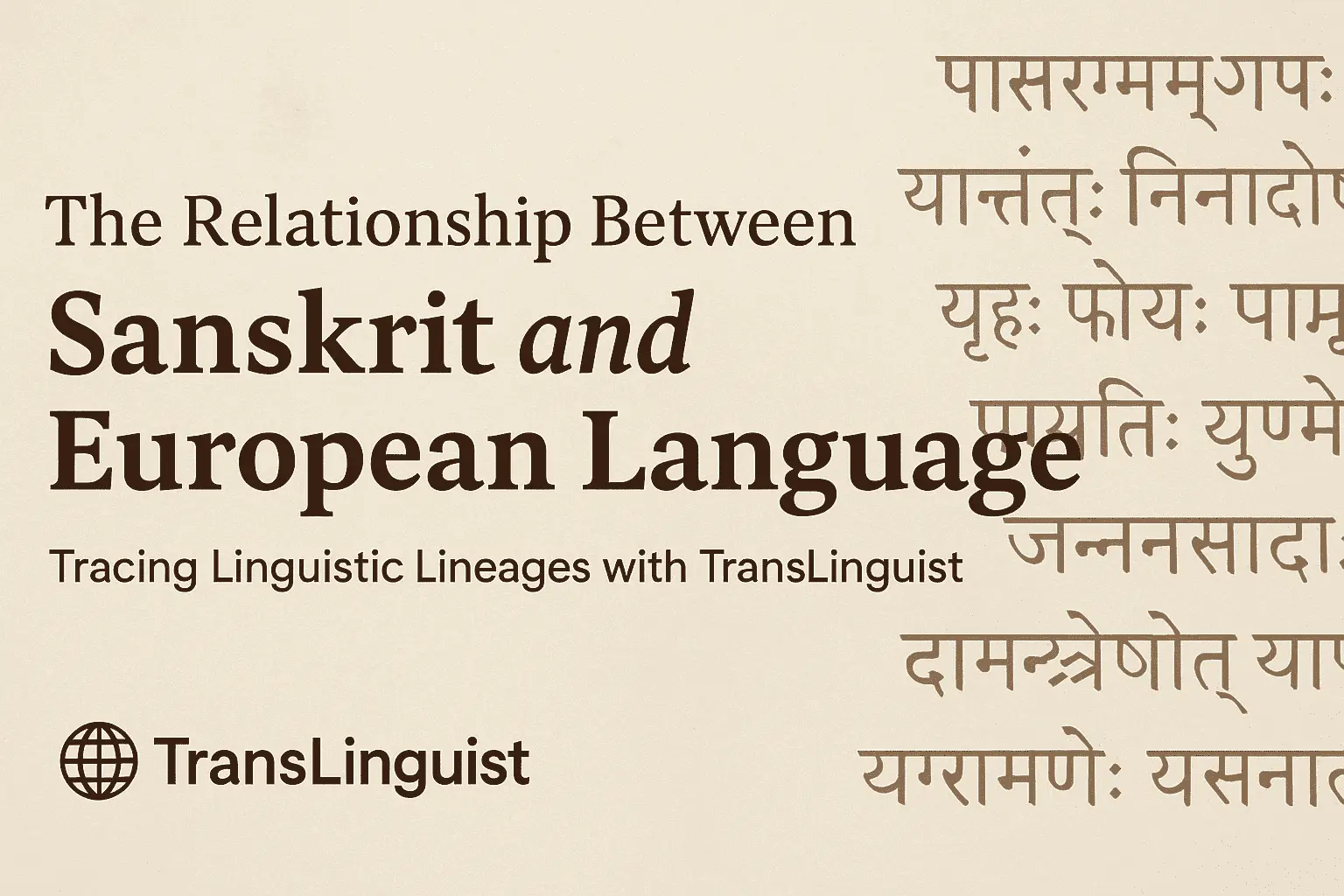Sanskrit is generally accepted to have been one of the first and most highly developed languages of humanity, the language of ancient India. In addition to its spiritual and literary importance, Sanskrit also occupies an interesting place in the field of linguistics. It has many affinities with most European languages for being part of the same Indo-European language family.
Let’s see how Sanskrit and European languages are connected and how TransLinguist helps in preserving this ancient linguistic heritage.
Sanskrit and Its Indo-European Roots
The fascinating relationship between Sanskrit and European languages begins with their shared roots. Sanskrit is part of the Indo-Aryan subgroup of the larger Indo-European family, which also includes Latin, Greek, English, German, and others. This Sanskrit and European languages relationship was first recognized in the 18th century when scholars like Sir William Jones identified striking similarities between Sanskrit, Latin, and Greek. His groundbreaking work founded the field of comparative linguistics, proving these languages all descended from a common ancestor: Proto-Indo-European.
TransLinguist helps you explore the past while effectively communicating in the present thanks to our global network of linguists and in-depth cultural knowledge.
Striking Similarities in Vocabulary
The relatedness of Sanskrit and European tongues can be observed even in mundane vocabulary. This means, for instance:
- The Sanskrit term Mātṛ (मातृ) is paralleled in Latin Mater, Greek Mētēr, and English “Mother”.
- Pitṛ (पितृ) is cognate with Pater, Patēr, and “Father”.
- Dānam (दानम्), gift, is similar to Latin Donum and to our English “donation”.
These commonalities are not coincidental; they point to a shared linguistic heritage.
Common Grammatical Foundations
Sanskrit, as well as many of the European languages, has the same structure. Similar to Latin and Greek, Sanskrit employs declensions and conjugations to mark grammatical relations. The use of roots and affixes to create verbs and nouns is also reminiscent of European language construction and assists linguists in tracking the language’s development in the past.
Sanskrit’s Role in Language Research
Sanskrit has been a central aid to the reconstruction of Proto-Indo-European, due to its scrupulously retained grammar and ancient literature. Researchers continue to depend on Sanskrit as they investigate historical linguistics, etymology, and the evolution of both Eastern and Western languages.
How TransLinguist Supports This Legacy
At TransLinguist, we realize the academic and cultural worth of ancient languages such as Sanskrit. Our services bridge the disparity between ancient knowledge and contemporary insight through:
- Scholarly translation of ancient literature
- Localization of philosophical, religious, and literary content
- Subtitling and transcription for multilingual media and films
- Assistance in academic research projects based on Indo-European studies. Our linguists not only deliver language skills but also cultural knowledge, so your content is preserved regardless of the language pair.
Why This Link Remains Important
The link between Sanskrit and European languages points to our common human past. It enhances cross-cultural communication and underpins everything from education and historical studies to international cooperation in linguistic conservation.
Begin Your Journey with TransLinguist
No matter if you’re working on translations of Vedic hymns or studying Indo-European roots of language, TransLinguist is your go-to ally. Get in touch now to book a free demo. Through our worldwide network of linguists and intensive cultural knowledge, we enable you to interpret the past and speak clearly today.
📨 Are you prepared to begin? Discover how we can assist with your next project by contacting us at TransLanguist
FAQs
To what extent is Sanskrit similar to European languages?
Sanskrit has marked relationship with Indo-European languages like Latin and English as derived from a parent language, Proto-Indo-European.
How was Sanskrit implicated in the discovery of Indo-European language relationships?
Sanskrit helped the student to discover the links that existed among the world major languages and subsequently the Indo-European language family.
Sanskrit and Germany are linked by what forms of language?
Sanskrit has some basic roots and vocabulary in common with the Germanic languages, such as English and German, being descendants of Proto-Indo-European.
What is the relationship between Sanskrit and Latin?
They are structurally similar and share many lexical items, being Indo-European languages.
Which is older, Latin or Sanskrit?
Both derived from the same Proto-Indo-European ancestor, but Sanskrit is said to have the oldest and most written records.



